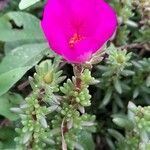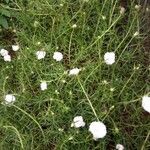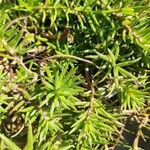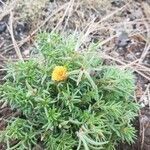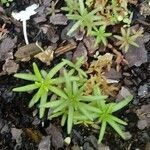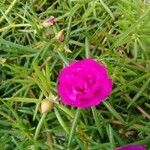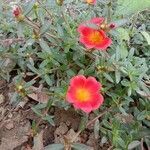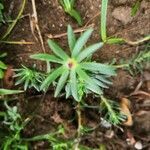Annual herb; stems ascending or prostrate, to 30 cm long, with nodal tufts of hairs. Leaves alternate; blade fleshy, terete or linear-cylindrical, 5-30 x 1-3 mm, obtuse, acute or acuminate at apex. Inflorescence a terminal cluster of 1-3 flowers, surrounded by long (2-3 mm) white or brownish hairs, and an involucre of 6-9(-12) leaves. Flowers to ca. 2.5 cm wide, often double (in horticulture); sepals unequal, deltoid-ovate, 6-10 x 6-8 mm, acute at apex; petals obovate, 1.5-2.5 x 1.5-2.5 cm, sometimes apically notched, whitish (wild), pink, salmon, purple, red or yellow, sometimes striped; stamens numerous, filaments filiform, to 7 mm long, anthers red, ca. 0.8 mm long; style to 1 cm long, stigmas ca. 10 through rebranching of style. Fruit conical, broadly ellipsoid or subglobose, 4-5 x 3-4.5 mm, circumscissile slightly below middle; seeds grey, tuberculate, metallic-iridescent.
Plants annual; roots fibrous. Stems prostrate to suberect; trichomes conspicuous at nodes and in inflorescence; branches to 30 cm. Leaf blades linear to lanceolate, terete to hemispheric, 5-30 × 1-5 mm, apex acute or subacute; involucrelike leaves 8-9(-14). Flowers 25-55 mm diam.; petals pink, red, purple, yellow, bronze, or white, obovate, 15-25 × 15-20 mm; stamens 40 or more; stigmas 5-8. Capsules ovoid, (3.5-)4-6.5 mm diam. Seeds steely gray, often iridescent, orbiculate or elongate, flattened, 0.75-1 mm diam.; surface cells obscurely stellate with tubercles mostly abaxially. 2n = 18.
A herb. It grows each year from seed. It grows 10-30 cm high. It spreads 15-30 cm wide. The stems lie along the ground. They are purple-red and with many branches. There are hairs clustered at the nodes. The leaves are crowded at the tips of the stem. The leaves are 10-25 mm long by 2-3 mm wide. The flowers are large. They are 2-4 cm across. They open at midday. The flowers can be red, purple, yellow or white. The fruit is a capsule with very small seeds. They are kidney shaped and less than 1 mm across.
Stems diffusely branched, ascending or widely spreading, 2–4 dm, hairy at the nodes; lvs linear, subterete, 1–3 cm, the cauline alternate, the terminal crowded, forming an involucre intermingled with long hairs; fls white or various brilliant shades of red or yellow, 2–4 cm wide; stamens numerous, ca 40 or more; style-branches 5–9; 2n=18, 36. Native of Argentina, occasionally escaped from cult. All summer.
Succulent annual herb, up to 150 mm tall. Stigmas red. Filaments reddish purple, anthers yellow. Flowers dark reddish pink.
Stem diffuse with long pale hairs at the nodes
A weed around houses.
Leaves terete
